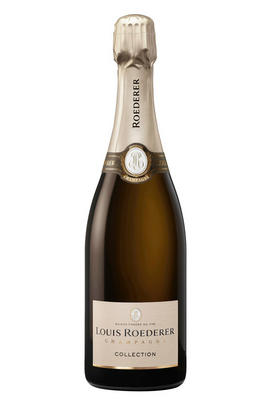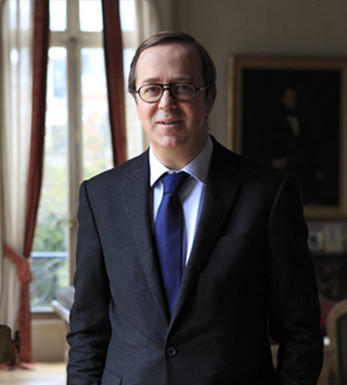
Champagne Louis Roederer, Collection 244, Brut

Critics reviews
The first impression is as invigorating as a sea breeze. I love the interplay of mirabelle, grapefruit and lychee fruit with minty freshness and waxiness from lees contact. And all this is welded to a beautifully proportioned palate with plenty of structure, bright acidity and the mousse animating. It's a very salty finish that pulls you back for more.
A cuvee of 41% Chardonnay, 33% Pinot Noir and 26% Pinot Meunier. Of these, 15% fermented in oak and 85% in stainless steel. The final blend contained 36% reserve perpetual and 10% reserve wines of the 2012 - 2018 vintage from oak. The dosage is 7 g/l.
Drink or hold
Stuart Pigott, Senior Editor at JamesSuckling.com (August 2023)
The powerful, ripe side of 2019 is on shown here, with white peach and mandarin flavours held in place by the toasty, savoury citrus oil snap of the perpetual reserve. It still feels youthful and fragrant with juicy pear, blossom and almond notes. It will show even better in another six months.
41% Chardonnay, 33% Pinot Noir and 26% Meunier. 54% from the 2019 base vintage, with 36% perpetual reserve and 10% reserve wines in oak.
Drink 2023 - 2028
Tom Hewson, Decanter.com (October 2023)
About this WINE

Louis Roederer
Founded in 1776, Louis Roederer is a family-owned, independent Champagne house with a well-deserved reputation for quality. It is managed by Frédéric Rouzaud, the seventh generation to be at the helm.
In 1876, Louis Roederer created the now-famous Cristal at the request of Alexander II. This once intensely sweet wine is now one of the most luscious, deeply flavoured champagnes available, with the '88, '89 and '90 among the greatest Cristals ever released.
Louis Roederer’s best-selling non-vintage blend for almost 40 years, Brut Premier, has recently been replaced by Collection 242. This new multi-vintage blend was created by Chef du Caves Jean-Baptiste Lécaillon in response to increasingly warm vintages. The cuvée aims to capture freshness and is based on a perpetual reserve which focuses on acidity and minerality.

Brut Champagne
Brut denotes a dry style of Champagne (less than 15 grams per litre). Most Champagne is non-vintage, produced from a blend from different years. The non-vintage blend is always based predominately on wines made from the current harvest, enriched with aged wines (their proportion and age varies by brand) from earlier harvests, which impart an additional level of complexity to the end wine. Champagnes from a single vintage are labelled with the year reference and with the description Millésimé.
Non-vintage Champagnes can improve with short-term ageing (typically two to three years), while vintages can develop over much longer periods (five to 30 years). The most exquisite and often top-priced expression of a house’s style is referred to as Prestige Cuvée. Famous examples include Louis Roederer's Cristal, Moët & Chandon's Dom Pérignon, and Pol Roger's Cuvée Sir Winston Churchill.
Recommended Producers : Krug, Billecart Salmon, Pol Roger, Bollinger, Salon, Gosset, Pierre Péters, Ruinart

Champagne blend
Which grapes are included in the blend, and their proportion, is one of the key factors determining the style of most Champagnes. Three grapes are used - Pinot Noir, Chardonnay and Pinot Meunier.
26% of vineyards in Champagne are planted with Chardonnay and it performs best on the Côtes des Blancs and on the chalk slopes south of Epernay. It is relatively simple to grow, although it buds early and thus is susceptible to spring frosts. It produces lighter, fresher wines than those from Burgundy and gives finesse, fruit and elegance to the final blend. It is the sole grape in Blancs de Blancs, which are some of the richest long-lived Champagnes produced.
Pinot Noir accounts for nearly 40% of the plantings in Champagne and lies at the heart of most blends - it gives Champagne its body, structure, strength and grip. It is planted across Champagne and particularly so in the southern Aube district.
The final component is Pinot Meunier and this constitutes nearly 35% of the plantings. Its durability and resistance to spring frosts make the Marne Valley, a notorious frost pocket, its natural home. It ripens well in poor years and produces a soft, fruity style of wine that is ideal for blending with the more assertive flavours of Pinot Noir. Producers allege that Pinot Meunier lacks ageing potential, but this does not deter Krug from including around 15% of it in their final blends.


Buying options
Add to wishlist
Description
The first impression is as invigorating as a sea breeze. I love the interplay of mirabelle, grapefruit and lychee fruit with minty freshness and waxiness from lees contact. And all this is welded to a beautifully proportioned palate with plenty of structure, bright acidity and the mousse animating. It's a very salty finish that pulls you back for more.
A cuvee of 41% Chardonnay, 33% Pinot Noir and 26% Pinot Meunier. Of these, 15% fermented in oak and 85% in stainless steel. The final blend contained 36% reserve perpetual and 10% reserve wines of the 2012 - 2018 vintage from oak. The dosage is 7 g/l.
Drink or hold
Stuart Pigott, Senior Editor at JamesSuckling.com (August 2023)
wine at a glance
Delivery and quality guarantee